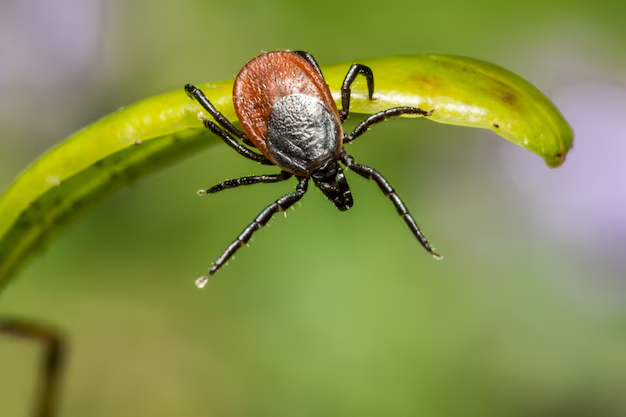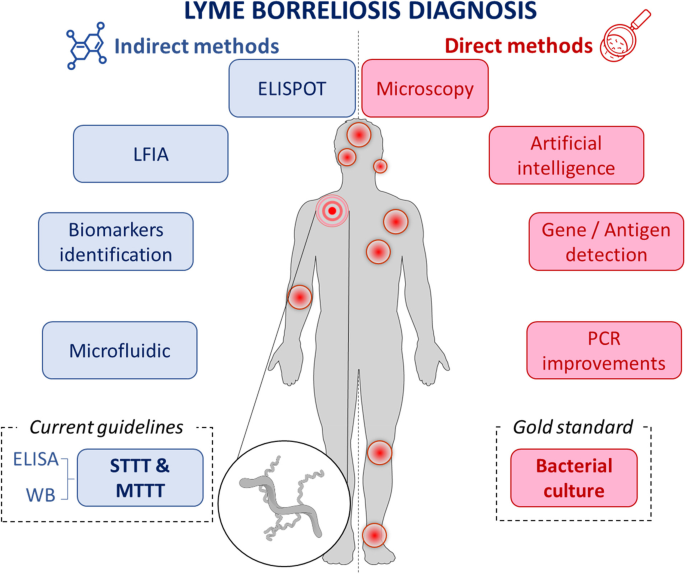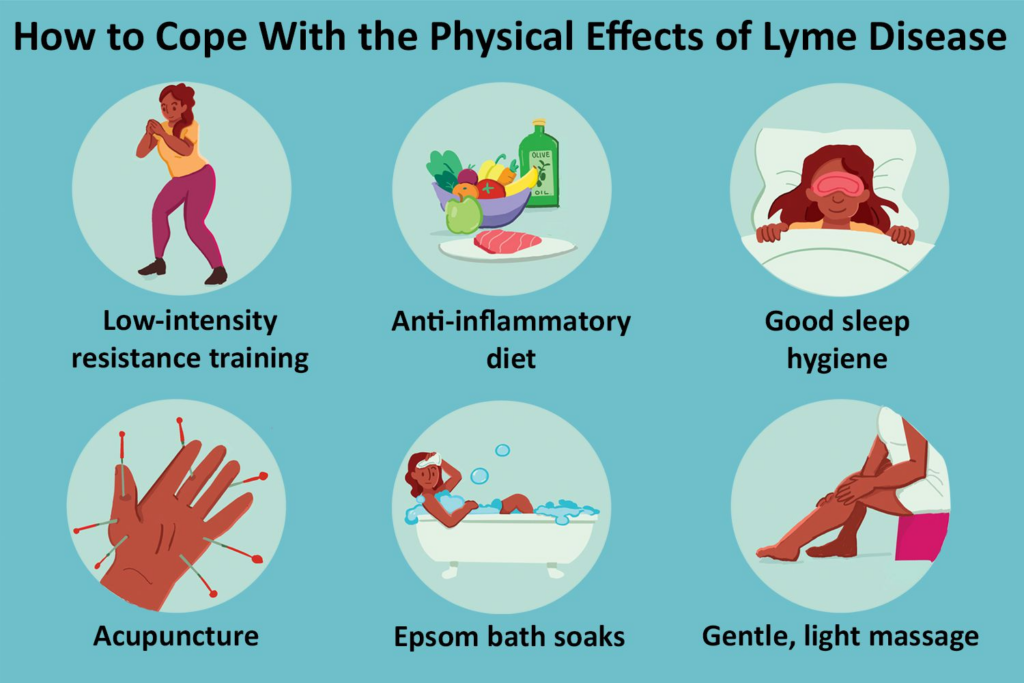Effective Treatment Options for Lyme Disease
A Complete Guide to Recovery


Lyme disease is extremely harmful if it is left unnoticed at the early stages. Therefore it necessitates the need for the knowledge of knowing and understanding the treatment options for Lyme disease. Even though the disease has multiple symptoms it has challenges in diagnosing it at the early stages. Let’s explore more into details of Lyme symptoms, diagnostic tests and the treatment options available to the patient.
What is Lyme Disease?
Lyme illness is an infection that is caused by infected tick bites that transmit the bacterium Borrelia burgdorferi into our blood during their feed. This illness is most common in parts of North America, Europe and Asia. These places have forests, woodlands and grasslands that are highly populated with ticks.
There are three stages related to the disease, they are listed below:
- Early-Localized Lyme Disease: The stage of the disease appears within a few days to a week of getting the tick bite. The symptoms at this stage include body aches, rashes, fatigue, and even a bit of chills and fever as well.
- Early Disseminated Lyme Disease: If the disease is unnoticed or left untreated it progresses to this stage. In this stage one may have high chances that the disease can spread to the person’s brain and heart leading to complications and serious conditions.
- Late Lyme Disease: Continuation of bacterial growth in the early stages leads to the development of extreme levels of fatigue and arthritis. This may become a long-term suffering for the patients.
Early detection and treatment prevents these complications, emphasizing the importance of Lyme diagnosis accuracy and prompt medical intervention.

How is Lyme Disease Diagnosed?
Accurate and early diagnosis is crucial for the effective treatment of Lyme disease. Physicians will consider all of the clinical assessments, medical histories, and tests in the laboratory to asses the infection.
ELISA Test
- Detects antibodies against Borrelia burgdorferi.
- Its sensitivity varies depending on the stage of the infection.
- Early infections will result in false negatives since not many antibodies are produced.
Western Blot Test
- Utilized to verify the ELISA results, whether they are positive or indeterminate.
- Detects specific proteins of Borrelia burgdorferi bacteria in the body.
- Reduces false positives when used together with ELISA.
PCR Test
- Detects DNA of the Borrelia burgdorferi in blood or tissue samples.
- Sensitive - but less specific when early in an infection.
CSF Analysis
- It detects any cases of Lyme-related neurologic symptomatology in the CSF.
- Performed when Lyme meningitis or neuroborreliosis suspected
Challenges to Lyme Testing
- Testing too early may miss with markers as the antibodies needed for detection are not produced.
- Fever and rashes tend to overlap with other infections hence making Lyme misdiagnosis.
- Timing and the combination of tests are critical for accuracy.
A holistic approach using these diagnostic methods ensures a precise diagnosis and proper treatment plan.
Treatment Options for Lyme Disease
Antibiotics serve as the primary treatment for patients suffering from Lyme disease. Depending on the patient condition the form (oral or intravenous) and dosage may vary. Following is the list of treatment options available.
Addressing Post-Treatment Lyme Disease Syndrome (PTLDS)
Even after getting antibiotic treatment some patients may experience muscle pain, fatigue or cognitive issues. This condition is termed as PTLDS (Post-Treatment Lyme Disease Syndrome). Nearly 10 to 20% of the patients suffer from this syndrome.
Why Does PTLDS Occur?
The reason behind the cause of PTLDS is not known. Some experts say that it is caused by the body’s own immune response towards the infection or it could be due to the inflammations that are caused to the body’s tissues by the bacterial infection.
Managing PTLDS Symptoms
Antibiotic treatment for long-term is ineffective for PTLDS hence it is important to focus on the following holistic treatments instead:
- Physical Therapy: Important for joint pain and stiffness.
- Cognitive Rehabilitation: Necessary for memory and concentration deficits.
- Stress Management: Essential for mental health, especially with chronic symptoms.
Holistic and Alternative Therapies for Lyme Disease
Antibiotics are considered as the primary form of treatment as it is the only option for Lyme disease. But inclusion of complementary or alternative therapies can improve health by enhancing the function of the immune system, and reducing inflammation.
- Herbal Protocols: Andrographis, Japanese knotweed, and cat’s claw which are known to be potent herbal anti infectives and anti-inflammatory agents.
- Acupuncture: This therapy involves stimulating certain points on the body through needles. It helps in pain reduction, improves blood flow, and eases fatigue and joint pain.
- Mind-Body Practices: Yoga, meditation, and mindfulness help reduce stress and improve relaxation, which are essential for managing chronic Lyme symptoms.
- Hyperbaric Oxygen Therapy (HBOT): The theory behind using this therapy is that breathing pure oxygen in a pressurized room would kill the Lyme bacteria, as it creates an environment where bacteria cannot thrive.
These therapies complement, but do not replace, evidence-based conventional medicine. Always consult your doctor before you proceed with alternative treatments.

Diet and Nutrition for Lyme Disease Recovery
Lyme disease recovery can be made faster with proper diet and nutrition. It helps to increase energy levels, reduce inflammation and strengthen immunity.
- Anti-Inflammatory Foods: The intake of food such as fatty fish, leafy greens, berries, nuts, and seeds are anti-inflammatory in nature reduces inflammation.
- Probiotics: The foods rich in probiotics such as yogurt, kefir, and fermented vegetables with antibiotics are essential to help restore gut health.
- Avoid Processed Foods: Processed foods and sugars as they will inhibit immunity and lead to inflammation. Better avoid such foods.
- Hydration: Proper hydration with water and herbal drinks, such as dandelion or ginger tea help with the detoxification process.
- Supplements for nutrition: In Lyme patients, there is a possibility of most common deficiencies in vitamins D, B-complex, and magnesium. Supplement may help feel better health.
Detoxing for Lyme: Does It Help?
Detoxification enables the body to flushout toxins resulting from the Jarisch-Herxheimer reaction. and helps in the fast recovery process.
- Epsom Salt Baths: Magnesium-rich Epsom salts help relax the person and relieve muscle aches.
- Dry Brushing: Dry brushing facilitates lymphatic drainage for removal of toxins.
- Sauna Therapy: Infrared sauna therapy encourages sweating as it enables the removal of toxins via the skin.
- Food Supports Liver Detox: These include beets, turmeric, and milk thistle.
Detoxification methods can ease symptoms but it should be combined with conventional medical treatment. Always take advice from your physician before considering any of the complementary methods in addition to medical treatment.
Physical Therapy for Lyme-Induced Joint Pain
Lyme arthritis ( joint inflammation) is one of the most common complications that patients may experience. Yet physical therapy can significantly relieve pain and restore joint function.
How Physical Therapy Assists
- Specific exercises can rehabilitate motion and improve flexibility.
- Massage and heat therapy techniques can help in pain reduction.
- Avoids chronic destruction by strengthening the joints.
- Maintains overall functionality as balance and coordination are improved.
Therapeutic Methods
- Hydrotherapy: Low-impact water therapy minimizes stress on joints.
- Electrical Stimulation: It helps in diminishing inflammation and pain in joints.
- Postural Training: It relieves strain and prevents further complications.
Combining physical therapy with medical care and lifestyle changes may enhance recovery and improve quality of life.
Conclusion: Managing Lyme Disease Effectively
Lyme disease needs timely intervention to prevent long-term complications. Lyme illness accuracy and reliability can be ensured with various tests like ELISA test, Western Blot test, and tick-borne tests. Seek help from healthcare professionals to guide you through diagnosis and treatment options for Lyme disease. Take the advice of your doctor and include complementary therapy options for the fast recovery.
